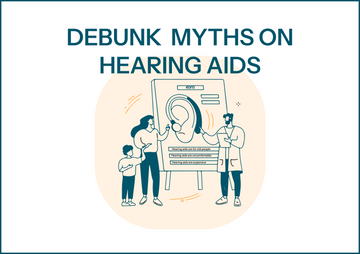“No one tells you how weird it can feel at first.”
That’s something a lot of people say after they start wearing hearing aids for the first time. Things sound different - not bad, just different. Your own voice feels louder, or you’re suddenly noticing the hum of the fridge you never paid attention to before.
In this post, we’ll share tips that can help you feel more comfortable and confident as you get used to your new hearing aids. Whether you’re wearing traditional models, trying out Bluetooth hearing aids, or exploring over the counter hearing aids for the first time.
Mental Readiness
A big part of adjusting to hearing aids is mental.
Start by setting realistic expectations. Hearing aids do not repair hearing loss or restore your hearing to how it was before. Instead, they amplify sounds to help you make the most of your remaining hearing. Many users begin to notice everyday sounds again; footsteps, the rustle of clothing, distant voices, but these sounds may feel unfamiliar or even intrusive at first.
It is also important to accept that hearing aids are now part of your every day routine.
Wear Regularly
To get used to your hearing aids, wear them daily, but ease into it. Start with a few hours at home, where background noises are softer and more familiar. This gives your brain time to adjust without being overwhelmed.
“Sensory overload is one of the main reasons people stop wearing hearing aids,” says Eara audiologist Dr. Andrea Cheng.
“Starting in a quiet space helps your brain adapt gradually. It usually takes about a month for the brain to fully adjust to new sound input.”
Sensory overload happens when your brain is flooded with more sound than it’s used to processing, especially after a long period of hearing loss. That’s why it’s important to go slow. Increase your wear time bit by bit each day, and try more complex listening environments only when you feel ready.
If you’re using over-the-counter hearing aids, they generally fall into two categories. A select few are self-fitting, meaning they come with an in-app hearing test that adjusts the device to your hearing needs. But most use preset programs, allowing you to choose from predefined settings based on common hearing loss patterns, more generic sound and therefore, lacking the clearest sound.
Need help easing into it all? Check out our weekly adjustment schedule designed by the audiologists at Eara; To guide you through a four-week plan that helps build comfort and confidence with your hearing aids.
Listening Practice
Once you’re wearing your hearing aids regularly, the next step is to help your brain get better at understanding sound.
Listen to audiobooks, podcasts, or TV at a regular volume. Ask a family member with normal hearing to set the volume, what sounds normal to them is a good target for you to aim for.
When chatting with family or friends, choose a quiet room and ask them to face you while speaking. Visual cues like lip movement and facial expressions are helpful, especially as your brain relearns how to process sound. It improves ear-eye coordination and helps you feel more confident in conversations.
Watching TV with subtitles on can also make a big difference. Your brain connects the words you’re reading with the sounds you’re hearing, filling in the blanks and strengthening those pathways over time. This kind of training helps “rewire” the brain, making listening feel more natural again.
Talk to a professional
If your hearing aids cause discomfort, itchiness, or even mild pain, don’t try to tough it out. Talk to a hearing professional as soon as possible. A quick adjustment or a small change in fit could make a big difference. This is why we, at Eara Hearing, offer 24/7 customer service support and Free Audiologist consultations for life!
Your audiologist and Eara Hearing team isn’t just there for the initial fitting; they’re a key part of your journey. From helping you get used to new sounds to answering questions that come up weeks or even months later, having access to expert guidance can be the difference between just wearing hearing aids and truly hearing well with them.
-
For prescription hearing aids: Regular follow-up appointments with your audiologist are typically included in your purchase. These professionals can fine-tune your devices as you adjust.
-
For over-the-counter options: Support varies significantly between brands. While all OTC hearing aids come with customer service, not all provide access to qualified audiologists for ongoing adjustments and guidance. This is an important distinction to consider when purchasing.
As an EARA customer, you'll have access to lifetime audiology support with your purchase. This means you can consult with our Audiologists remotely whenever questions arise; whether you've had your hearing aids for a week or a year.
Stay positive and challenge yourself
You've done the hard part by getting started, now focus on staying positive and taking small steps each day with your hearing aids. Progress happens gradually, so even if things feel slow at first, maintaining a good attitude will make a real difference in your comfort and confidence.
Celebrate small wins, like catching familiar sounds you might have missed before. Challenge yourself by wearing your hearing aids in more complex environments; Group conversations or busy places and practice identifying who’s speaking. Devices like EARA hearing aids- with directional microphones, can make this easier.
Staying motivated is key. You might want to journal your progress, join online communities, or share your journey on social media to connect with others. The more you challenge yourself, the quicker you'll adapt and enjoy all the new sounds around you.
The adjustment period with hearing aids is temporary, but the benefits will last for years to come. Within a few weeks of following these tips, many users find their devices become a natural part of daily life. You'll soon rediscover the joy of effortless conversations.
























